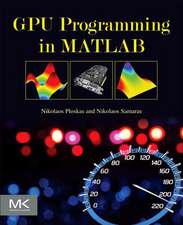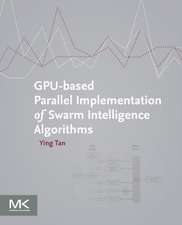From Parallel to Emergent Computing
Editat de Andrew Adamatzky, Selim Akl, Georgios Ch. Sirakoulisen Limba Engleză Paperback – 30 sep 2020
Features
- Truly interdisciplinary, spanning computer science, electronics, mathematics and biology
- Covers widely popular topics of future and emergent computing technologies, cloud computing, parallel computing, DNA computation, security and network analysis, cryptography, and theoretical computer science
- Provides unique chapters written by top experts in theoretical and applied computer science, information processing and engineering
From Parallel to Emergent Computing provides a visionary statement on how computing will advance in the next 25 years and what new fields of science will be involved in computing engineering. This book is a valuable resource for computer scientists working today, and in years to come.
| Toate formatele și edițiile | Preț | Express |
|---|---|---|
| Paperback (1) | 384.55 lei 6-8 săpt. | |
| CRC Press – 30 sep 2020 | 384.55 lei 6-8 săpt. | |
| Hardback (1) | 741.74 lei 6-8 săpt. | |
| CRC Press – 6 feb 2019 | 741.74 lei 6-8 săpt. |
Preț: 384.55 lei
Preț vechi: 480.69 lei
-20% Nou
Puncte Express: 577
Preț estimativ în valută:
73.58€ • 76.83$ • 60.90£
73.58€ • 76.83$ • 60.90£
Carte tipărită la comandă
Livrare economică 04-18 aprilie
Preluare comenzi: 021 569.72.76
Specificații
ISBN-13: 9780367656607
ISBN-10: 0367656604
Pagini: 628
Dimensiuni: 178 x 254 x 32 mm
Greutate: 1.08 kg
Ediția:1
Editura: CRC Press
Colecția CRC Press
ISBN-10: 0367656604
Pagini: 628
Dimensiuni: 178 x 254 x 32 mm
Greutate: 1.08 kg
Ediția:1
Editura: CRC Press
Colecția CRC Press
Notă biografică
Andrew Adamatzky is Professor of Unconventional Computing and Director of the
Unconventional Computing Laboratory, Department of Computer Science, University
of the West of England, Bristol, United Kingdom. He does research in molecular computing,
reaction-diffusion computing, collision-based computing, cellular automata,
slime mould computing, massive parallel computation, applied mathematics, complexity,
nature-inspired optimisation, collective intelligence and robotics, bionics,
computational psychology, non-linear science, novel hardware, and future and emergent
computation. He authored seven books, including Reaction-Diffusion Computers
(Elsevier, 2005), Dynamics of Crowd-Minds (World Scientific, 2005), and Physarum
Machines (World Scientific, 2010), and edited 22 books in computing, including Collision
Based Computing (Springer, 2002), Game of Life Cellular Automata (Springer, 2010),
and Memristor Networks (Springer, 2014); he also produced a series of influential
artworks published in the atlas Silence of Slime Mould (Luniver Press, 2014). He is
founding editor-in-chief of the Journal of Cellular Automata (2005–) and the Journal
of Unconventional Computing (2005–) and editor-in-chief of the Journal of Parallel,
Emergent, Distributed Systems (2014–) and Parallel Processing Letters (2018–).
Selim G. Akl (Ph.D., McGill University, 1978) is a Professor at Queen’s University
in the Queen’s School of Computing, where he leads the Parallel and Unconventional
Computation Group. His research interests are primarily in the area of algorithm
design and analysis, in particular for problems in parallel computing and unconventional
computing. Dr. Akl is the author of Parallel Sorting Algorithms (Academic Press,
1985), The Design and Analysis of Parallel Algorithms (Prentice Hall, 1989), and
Parallel Computation: Models and Methods (Prentice Hall, 1997). He is co-author of
Parallel Computational Geometry (Prentice Hall, 1993), Adaptive Cryptographic Access
Control (Springer, 2010), and Applications of Quantum Cryptography (Lambert, 2016).
Georgios Ch. Sirakoulis is a Professor in Department of Electrical and Computer
Engineering at Democritus University of Thrace, Greece. His current research emphasis
is on complex electronic systems, future and emergent electronic devices, circuits,
models and architectures (memristors, quantum cellular automata, etc.), novel computing
devices and circuits, cellular automata, unconventional computing, high-performance
computing, cyber-physical and embedded systems, bioinspired computation and
bioengineering, FPGAs, modelling, and simulation. He co-authored two books, namely
Memristor-Based Nanoelectronic Computing Circuits and Architectures (Springer,
2016) and Artificial Intelligence and Applications (Krikos Publishing, 2010) and coedited
three books.
Descriere
From Parallel to Emergent Computing provides a visionary statement on how computing will advance in the next 25 years and what new fields of science will be involved in computing engineering. This book is a valuable resource for computer scientists working today, and in years to come.
Cuprins
Contents
Preface...............................................................................................................................ix
Editor Bios.........................................................................................................................xi
Contributors....................................................................................................................xiii
Editorial Boards of the International Journal of Parallel, Emergent and
Distributed Systems.......................................................................................................xix
Part 1 Networks and Parallel Computing
Chapter 1 On the Importance of Parallelism for the Security of
Quantum Protocols 3
Marius Nagy and Naya Nagy
Chapter 2 Analytical Modeling and Optimization of an Elastic Cloud
Server System 31
Keqin Li
Chapter 3 Towards an Opportunistic Software-Defined Networking
Solution 49
Lefteris Mamatas, Alexandra Papadopoulou, and
Vassilis Tsaoussidis
Chapter 4 Structural Properties and Fault Resiliency of
Interconnection Networks 77
Eddie Cheng, Rong-Xia Hao, Ke Qiu, and Zhizhang Shen
Part 2 Distributed Systems
Chapter 5 Dynamic State Transitions of Individuals Enhance
Macroscopic Behavioral Diversity of Morphogenetic
Collective Systems 105
Hiroki Sayama
Chapter 6 Toward Modeling Regeneration via Adaptable Echo State
Networks 117
Jennifer Hammelman, Hava Siegelmann, Santosh Manicka, and
Michael Levin
Chapter 7 From Darwinian Evolution to Swarm Computation and
Gamesourcing 135
Ivan Zelinka, Donald Davendra, Lenka Skanderová, Tomáš
Vantuch, Lumír Kojecký, and Michal Bukáček
Chapter 8 A Scalable and Modular Software Architecture for Finite
Elements on Hierarchical Hybrid Grids 177
Nils Kohl, Dominik Thönnes, Daniel Drzisga,
Dominik Bartuschat, and Ulrich Rüde
Chapter 9 Minimal Discretised Agent-Based Modelling of the
Dynamics of Change in Reactive Systems 199
Tiago G. Correale and Pedro P.B. de Oliveira
Chapter 10 Toward a Crab-Driven Cellular Automaton 221
Yuta Nishiyama, Masao Migita, Kenta Kaito, and
Hisashi Murakami
Chapter 11 Evolving Benchmark Functions for Optimization
Algorithms 239
Yang Lou, Shiu Yin Yuen, and Guanrong Chen
Chapter 12 Do Ant Colonies Obey the Talmud? 261
Andrew Schumann
Chapter 13 Biomorphs with Memory 273
Ramón Alonso-Sanz
Chapter 14 Constructing Iterated Exponentials in Tilings of the
Euclidean and of the Hyperbolic Plane 285
Maurice Margenstern
Chapter 15 Swarm Intelligence for Area Surveillance Using
Autonomous Robots 315
Tilemachos Bontzorlos, Georgios Ch. Sirakoulis, and Franciszek
Seredynski
Part 3 Emergent Computing
Chapter 16 Unconventional Wisdom: Superlinear Speedup and
Inherently Parallel Computations 347
Selim G. Akl
Chapter 17 Algorithmic Information Dynamics of Emergent,
Persistent, and Colliding Particles in the Game of Life 367
Hector Zenil, Narsis A. Kiani, and Jesper Tegnér
Chapter 18 On Mathematics of Universal Computation with Generic
Dynamical Systems 385
Vasileios Athanasiou and Zoran Konkoli
Chapter 19 Localized DNA Computation 407
Hieu Bui and John Reif
Chapter 20 The Graph Is the Message: Design and Analysis of an
Unconventional Cryptographic Function 425
Selim G. Akl
Chapter 21 Computing via Self-optimising Continuum 443
Alexander Safonov
Chapter 22 Exploring Tehran with Excitable Medium 475
Andrew I. Adamatzky and Mohammad Mahdi Dehshibi
Chapter 23 Feasibility of Slime-Mold-Inspired Nano-Electronic
Devices 489
Takahide Oya
Chapter 24 A Laminar Cortical Model for 3D Boundary and Surface
Representations of Complex Natural Scenes 509
Yongqiang Cao and Stephen Grossberg
Chapter 25 Emergence of Locomotion Gaits Through Sensory
Feedback in a Quadruped Robot 547
Paolo Arena, Andrea Bonanzinga, and Luca Patanè
Chapter 26 Towards Cytoskeleton Computers. A Proposal........................... 575
Andrew I. Adamatzky, Jack Tuszynski, Jörg Pieper, Dan V.
Nicolau, Rosaria Rinaldi, Georgios Ch. Sirakoulis, Victor
Erokhin, Jörg Schnauß, and David M. Smith
Index 597
Preface...............................................................................................................................ix
Editor Bios.........................................................................................................................xi
Contributors....................................................................................................................xiii
Editorial Boards of the International Journal of Parallel, Emergent and
Distributed Systems.......................................................................................................xix
Part 1 Networks and Parallel Computing
Chapter 1 On the Importance of Parallelism for the Security of
Quantum Protocols 3
Marius Nagy and Naya Nagy
Chapter 2 Analytical Modeling and Optimization of an Elastic Cloud
Server System 31
Keqin Li
Chapter 3 Towards an Opportunistic Software-Defined Networking
Solution 49
Lefteris Mamatas, Alexandra Papadopoulou, and
Vassilis Tsaoussidis
Chapter 4 Structural Properties and Fault Resiliency of
Interconnection Networks 77
Eddie Cheng, Rong-Xia Hao, Ke Qiu, and Zhizhang Shen
Part 2 Distributed Systems
Chapter 5 Dynamic State Transitions of Individuals Enhance
Macroscopic Behavioral Diversity of Morphogenetic
Collective Systems 105
Hiroki Sayama
Chapter 6 Toward Modeling Regeneration via Adaptable Echo State
Networks 117
Jennifer Hammelman, Hava Siegelmann, Santosh Manicka, and
Michael Levin
Chapter 7 From Darwinian Evolution to Swarm Computation and
Gamesourcing 135
Ivan Zelinka, Donald Davendra, Lenka Skanderová, Tomáš
Vantuch, Lumír Kojecký, and Michal Bukáček
Chapter 8 A Scalable and Modular Software Architecture for Finite
Elements on Hierarchical Hybrid Grids 177
Nils Kohl, Dominik Thönnes, Daniel Drzisga,
Dominik Bartuschat, and Ulrich Rüde
Chapter 9 Minimal Discretised Agent-Based Modelling of the
Dynamics of Change in Reactive Systems 199
Tiago G. Correale and Pedro P.B. de Oliveira
Chapter 10 Toward a Crab-Driven Cellular Automaton 221
Yuta Nishiyama, Masao Migita, Kenta Kaito, and
Hisashi Murakami
Chapter 11 Evolving Benchmark Functions for Optimization
Algorithms 239
Yang Lou, Shiu Yin Yuen, and Guanrong Chen
Chapter 12 Do Ant Colonies Obey the Talmud? 261
Andrew Schumann
Chapter 13 Biomorphs with Memory 273
Ramón Alonso-Sanz
Chapter 14 Constructing Iterated Exponentials in Tilings of the
Euclidean and of the Hyperbolic Plane 285
Maurice Margenstern
Chapter 15 Swarm Intelligence for Area Surveillance Using
Autonomous Robots 315
Tilemachos Bontzorlos, Georgios Ch. Sirakoulis, and Franciszek
Seredynski
Part 3 Emergent Computing
Chapter 16 Unconventional Wisdom: Superlinear Speedup and
Inherently Parallel Computations 347
Selim G. Akl
Chapter 17 Algorithmic Information Dynamics of Emergent,
Persistent, and Colliding Particles in the Game of Life 367
Hector Zenil, Narsis A. Kiani, and Jesper Tegnér
Chapter 18 On Mathematics of Universal Computation with Generic
Dynamical Systems 385
Vasileios Athanasiou and Zoran Konkoli
Chapter 19 Localized DNA Computation 407
Hieu Bui and John Reif
Chapter 20 The Graph Is the Message: Design and Analysis of an
Unconventional Cryptographic Function 425
Selim G. Akl
Chapter 21 Computing via Self-optimising Continuum 443
Alexander Safonov
Chapter 22 Exploring Tehran with Excitable Medium 475
Andrew I. Adamatzky and Mohammad Mahdi Dehshibi
Chapter 23 Feasibility of Slime-Mold-Inspired Nano-Electronic
Devices 489
Takahide Oya
Chapter 24 A Laminar Cortical Model for 3D Boundary and Surface
Representations of Complex Natural Scenes 509
Yongqiang Cao and Stephen Grossberg
Chapter 25 Emergence of Locomotion Gaits Through Sensory
Feedback in a Quadruped Robot 547
Paolo Arena, Andrea Bonanzinga, and Luca Patanè
Chapter 26 Towards Cytoskeleton Computers. A Proposal........................... 575
Andrew I. Adamatzky, Jack Tuszynski, Jörg Pieper, Dan V.
Nicolau, Rosaria Rinaldi, Georgios Ch. Sirakoulis, Victor
Erokhin, Jörg Schnauß, and David M. Smith
Index 597












